#mind mapping examples you can use
Explore tagged Tumblr posts
Text
gonna show u guys a little opalescent highlight hack i threw together today
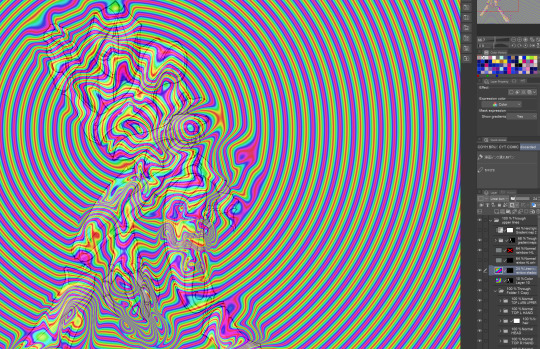
rainbow gradient above your main figure (i usually have all my main figure folders/layers in one big folder, so i can clip gradient maps + adjustments to it!). liquify tool to push the colors around a bit. STAY WITH ME I KNOW IT LOOKS STUPID RN I'M GOING SOMEWHERE WITH THIS
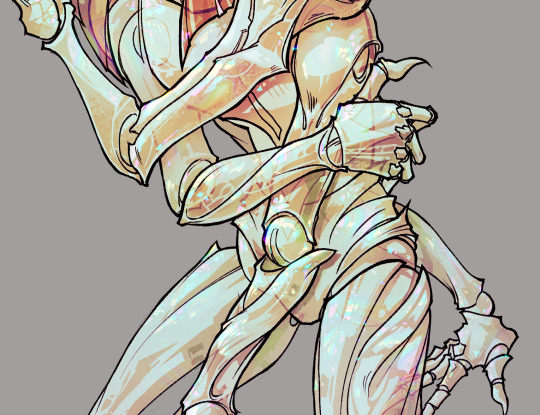
THEN: set it to add/glow (or the equivalent in ur drawing program), lower the opacity a bit, and apply a layer mask. then u can edit the mask with whatever tools you like to create rainbow highlights!!
in this case i'm mostly using the lasso fill tool to chip out little facets, but i've also done some soft airbrushing to bring in larger rainbow swirls in some areas. it's pretty subtle here, but you can see it better when i remove the gradient map that's above everything, since below i'm working in greyscale:
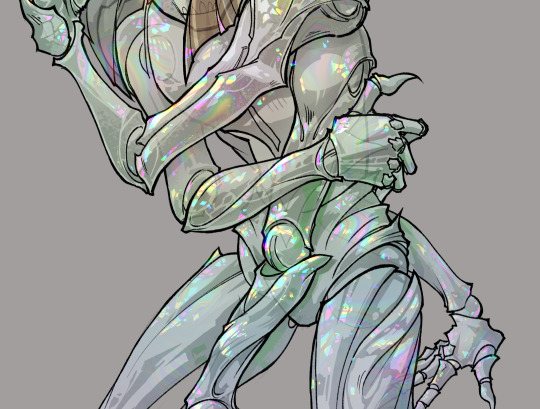
more granular rambling beneath the cut!
u could also just do this with a brush that has color jitter, but what i like about using layer masks for highlight/shading layers is how simple and reversible it makes everything. i can use whatever brushes i want, and erasing/redoing things is super low stakes, which is great when i often approach this stuff with a super trial-and-error approach.
example: have u ever thrown a gradient w multiple colors over an entire piece, set it to multiply etc, and then tried to erase it away to carve out shadows/highlights? it's super frustrating, bc it looks really good, but if u erase something and then change ur mind later, u basically would have to like. recreate the gradient in the area u want to cover up again. that's how i used to do things before figuring out layer masks!! but masking basically creates a version of this with INFINITE undo bc u can erase/re-place the base layer whenever u want.
anyway, back to rambling about this specific method:
i actually have TWO of these layers on this piece (one with the liquified swirls shown above, and another that's just a normal concentric circle gradient with much broader stripes) so i can vary the highlights easily as needed.
since i've basically hidden the rainbow pattern from myself, the colors in each brushstroke i make will kind of be a surprise, which isn't always great -- but easily fixable! for example, if i carve out a highlight and it turns out the rainbow pattern in that area is way too stripey, i can just switch from editing the mask to editing the main layer and blur that spot a bit.
also, this isn't a full explanation of the overall transparency effect in these screencaps! there's other layer stuff happening below the rainbow highlights, but the short version is i have all this character's body parts in different folders, each with their own lineart and background fill, and then the fill opacity is lowered and there's multiply layers clipped to that -- blah blah it's a whole thing. maybe i'll have a whole rundown on this on patreon later. uhhh i think that's it tho! i hope u get something useful out of this extremely specific thing i did lmao
12K notes
·
View notes
Text

sorry I know I’m being extremely annoying right now but the claim that the electronic calculator ‘did not forcibly pervade every aspect of our lives’ is so boldly and confidently wrong it’s impressive. the ability to automate the act of quantification (ie what an electronic calculator does) is probably as central to modern commerce and society as like, the transistor or the lightbulb. a world where excel spreadsheets do not exist is a fundamentally alien one to most people on planet earth. all geospatial software is built on the ability to do math on the fly. can you imagine the world today without google maps? can you even begin to comprehend a society not dominated by numbers? even these examples undersell how fundamental automated calculations are because this technology did in fact pervade every aspect of life. the fact that you think a calculator is simply a plastic doohickey you were taught to use in grade nine math is maliciously literal. like these arguments are so nakedly and openly anti-intellectual that I would say it makes it clear that no one should take you seriously, but posting this kind of mind-numbing slop is one of the easiest ways to do numbers on tumblr right now, which is something you also wouldn’t be able to do without the invention of an electronic calculator
3K notes
·
View notes
Text
Minecrafters Using Reference
Reference as in real world architecture, not other minecrafters' builds, though that's a fair way to learn too. Studying real world architecture gives insights about designing buildings, while studying other minecrafters would give insight into how to accomplish certain effects in Minecraft.
I didn't have more than passing interest in architecture before watching mcyt, but now whenever I'm outside, I'm evaluating the buildings around me. Do I like their shape? color? Any interesting details? Any wear or texture? And above all: How would you do that detail/shape/etc in minecraft? (please note: I don't even play minecraft)
Rendition and Inspiration
There's a minecraft project called BuildtheEarth that's replicating the earth in minecraft on a 1 to 1 scale. There's some fantastic builds on there.
On hermitcraft, Joe Hills is known for creating to scale renditions of real world places/objects. In season 10, he's tackled a project of massive scale with Bell Labs. He used a map from the library of congress to layout all the shapes!


These are examples of renditions/replicas/copies/whatever you want to call it (Although Joe's doubles as a community build area in place of massive parking lots).
Then there's using the buildings for inspiration. This may involve just taking bits and pieces. Or maybe you just take a color palette. Or maybe just the shape. Maybe you don't take anything but vibes. As a general rule, I think having multiple sources of inspiration is important so the new build doesn't end up feeling like a rendition instead of its own thing.
Bdubs in season 9 used the bakery from Kiki's Delivery Service as inspiration for his mud cafe. It can be seen in the wood framing, the stairs, the archway, the shape, the shed, the chimney designs. But the colors, the composition, Bdubs made changes that made it his own and combined the addition to his previous shop Moss o Menos.


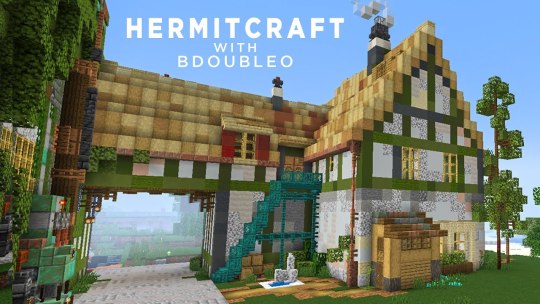
The aesthetics of Geminitay's season 10 base is based on the video game Dredge. I feel like the most obvious influence is in her research castle and fishing boats. She used inspiration from the spooky sea creatures in the game to create a uniquely frightening angler shop.

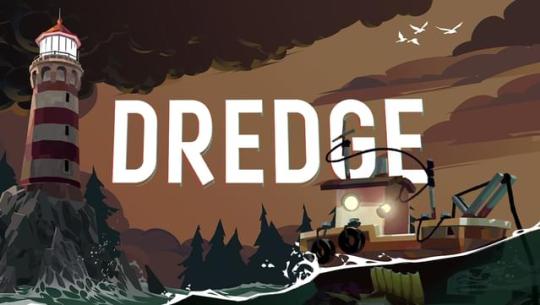
In Pearl's Build a Day series, she did a week focused on real world places. Here's the one she designed after a countryside home in Australia (her home country):


Goodtimeswithscar in season 7, when starting Aqua Town, based his shop on old department stores:


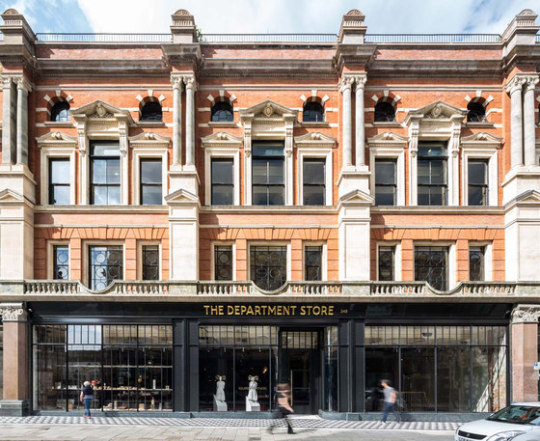
I like looking at his Aqua Town builds in comparison to his Scarland Main Street facades, which draw additional inspiration from Disneyland:





I feel like, comparing the builds you can see how he's grown; he's learned new detailing tricks, found colors and textures that work better with the architecture style. The main street has a similar layout to Disneyland, but his buildings are all unique.
Mogswamp is working on a massive build that's based on architecture drawings from Renzo Picasso:


He's incorporating groin vaults from roman architecture too!
I think builders learning about existing architecture is so good. It can give them so many ideas to add into their toolbox. It reminds them of small details that give builds life, like small sheds, some pipes, porches. And the builds don't need to be realistic; My mind goes to work by Shovel and Joel. Or everything Mumbo has done in season 10.
2K notes
·
View notes
Text
Other Misc. Rambling Thoughts on the topic:
(~ !!!!!!!!! if you're just reblogging this post for the Poll section, please reblog the original post without this addition* lol. ~)
(*not that there's anything super personal or weird about the addition, just that it's meant to be kind of casual Side Commentary, not really part of the Main Point Of The Poll, so it would feel kind of weird for it to be emphasized by being included in reblogs unless the reblogs were explicitly about the side commentary, etc..... if that makes sense.. ANYWAY!)
It's neat to read the written descriptions that people are mentioning in the tags, since it's almost like I can see or conceptualize the idea as well, but it's just.. I'm not SEEING it.
Like for example: I can imagine a vase, it's a muted mint green and slightly translucent, elaborate golden birds sprawled down the side in streaks of thin rough watery paint, the base material shimmers gently in the light, there's a small chip where it's cracked on the handle, etc, etc. .. But as I'm thinking about this I see literally nothing.
It seems like perhaps some people can visualize an object first, and THEN describe what they see. But I sort of work backwards. I am building the object in my mind, I can never see it, but it's a collection of concepts. Rather than visualizing all details as a whole at once, I am adding each detail one by one, building onto the IDEA of the thing.
The vase doesn't have a crack on the handle because I just automatically visualized a vase with a crack. It was more that I cognitively understand the concept of a vase, what they tend to be made out of, how they tend to look and feel, the properties they have. So based purely on that knowledge, I can imagine "a chip is something that a vase could have, it would look this way and behave this way" - more like... I'm constructing a bullet point Fact List about the object rather than seeing it.
So if you tell me to imagine an object, I can, in a way, imagine that object in great detail, but it's just.. I'm not SEEING those details, more just knowing it's qualities in a purely conceptual way. Sometimes in the tags when people are like "yeah I can see the skin of the apple, texture, little dots on the surface" it's like… I can imagine that too, I can know it's there, but just with no visual attached.
I guess rather than SEEING something and going ''ah. I know what this looks like because I have seen it''. I more just skip that visual step entirely and go ''I know what this looks like, I just randomly have a list of information about the concept in my mind.'' etc. Maybe similar to how sometimes in dreams, even though a house may look completely different and be in an entirely fake 'dreamlike' environment, you just somehow KNOW intuitively that it's meant to be your childhood home or something. Even when it looks nothing like it in reality. There's a built-in base knowledge of the properties or information of some things within a dreaming mind, etc.
--
This also makes me wonder about like.. how storytelling and myth is so important to cultures all across time. Or how this could tie also into concepts of religion.. etc. etc. If so many people really can kind of conjure these vivid images in their mind, then maybe that's part of why certain things are so meaningful to them? Like a "religious experience" being something you can actually really SEE/feel/lingering with you in your head, rather than just abstract words on a page, detached purely theoretical ideas, etc... hmmm
.
Plus also just for average emotional stuff too, even outside of broader cultural conceptual attachments..
Like, I don't think there's a direct 1 to 1 link (obviously not all people with mental illnesses that significantly reduce their emotional or expressive capacity also MUST have aphantasia or vice versa), but it's interesting as someone who DOES also have a much more lessened emotional range/pretty flat affect/etc. etc. to think like.. Maybe I WOULD be more emotional, in a way, if I could have these vivid experiences..?
Perhaps memories would hold deeper significance if they could really stay with me vividly. Or storytelling would evoke more of a deep emotional reaction to me if I could really picture and feel the things that are going on. If things were more TANGIBLE in my brain, rather than always merely conceptual highly abstracted ideas.
Kind of like, it's probably easier to get over the death of a pet or something, if after not seeing them for an hour you already don't remember what they looked like (beyond just a vague fact list of traits), and you have no vivid memories or mental reminders of them (beyond just factual information stores). COGNTIVIELY you can appreciate the idea of their absence, of course, you still miss them, but there's just no remaining visceral sensory ties. A very "out of sight, out of mind" sort of thing in terms of attachments, memories, emotions, etc. Maybe certain things are easier to "get over", when you're not having constant mental sensory reminders that occasionally rekindle your feelings about the event or etc.??
(like for example, maybe someone could remain angry about an argument longer if they could vividly replay it in their head over and over again. VS just like.. 'Yes I can factually recall the fact I had an argument, and I do have knowledge stored about what precisely was said, but any sort of sensory data such as sights/smells/feelings, etc. from the actual moment of the event are long gone and can never be conjured again in my mind." etc.)
Which again, I think lessened emotional permanence and image permanence in the mind are NOT inherently linked, can all be caused by different things for different people. And, since I can't visualize anything in my head, maybe I'm misunderstanding how it happens and the effect it may have on stuff like remembering things you miss or replaying arguments, etc. etc. But it's still a little interesting to think about, if they could influence each other to some degree.... :0c --
Lastly, It's also weird because I'm actually pretty good at estimating distance and spaces? I can quickly assemble furniture without an instruction manual, pretty easily have a concept of how much space a chair may take up in a room, how two mechanical parts might fit together - BUT, I am literally not actually visualizing anything. I cannot see 3D objects in my mind at ALL. It's like.. just based on the pure List Of Facts About Things Which I Have Observed.. I can intuitively go "oh this works like this/this is this size" just because.. I know it's that size. I don't have to see anything to know..?
But then on the other hand, I'm terrible at directions without a map (I guess because a 3d outdoor environment has WAY more complexity than like.. "Will this square fit into another square?"etc. lol ).
BUT, I also draw/sculpt/etc. entirely without references, and seem to do mostly okay at that..? Like.. I can't even remember the last time I actually used a reference or looked at anything whilst drawing. It's all muscle memory, and me just adjusting as I go until something "looks right" on paper, I never have a set image in my head (or external reference) before hand.. Hrmm....
AND.. I used to say that I had a photographic memory when I was younger, which I know NOW is not true (I always thought it was just an expression, not that people could literally see things in a photographic way). But what I was describing is, I do often associate information with imagery, just... without imagery....
Like "Oh, I know that I took my medicine earlier today because I have a distinct memory, a snapshot of a moment in time, of me rattling the pill bottle in my hands as I looked up at a stop sign while in the back seat of a car". When I say this, I can't ACTUALLY see/feel/hear a pill bottle, or vividly picture a stop sign, but it's more just a factual recall, of. Even though I don't see these things, I know they happened, the information of them happening (me hearing a sound and also looking at a stop sign at the same time) has been stored in my brain as a memory, a collection of linked facts. --
As for other senses, I cannot taste or feel anything in my head AT ALL.. wild that some people mention that. I mean, again, I can have a purely factual recall as if reading a textbook, knowing the information of 'X item typically has X texture, therefore I can imagine what it may be like to feel it' or 'X usually has this taste' etc. - but I can never actually experience those senses in any capacity in my mind alone. I would say audio is my strongest mental sense (maybe a 2.5 or 3 (if it were translated onto the above scale where 1 is most vivid and 5 is nothing)), then visual (4.5 at most, usually 5), and then taste and smell and such are just complete 5, absolutely nothing, I didn't even know people could experience taste or feeling just in their mind alone.. lol...
I know this is just a silly bad quality random screencap of a screencap that I found on facebook lol, BUT it's a succinct enough image to easily describe the concept in a quick/accessible way hopefully :
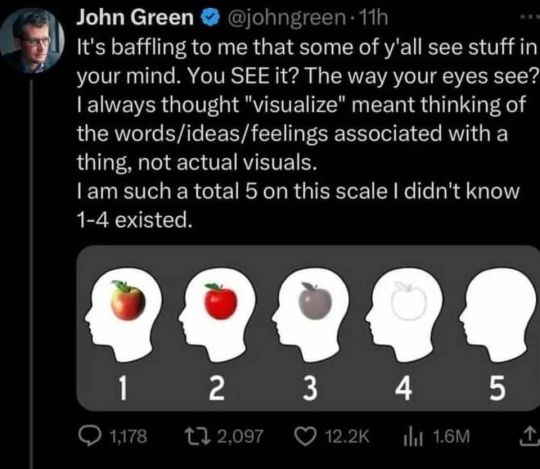
-
(and of course, feel free to elaborate in tags, etc.! (especially elaborating about other senses as well.. can you "hear" in your mind just as well as you can "see"? taste? etc.) It's an interesting topic to me, as someone who's like a 4.5 at MOST lol. I'm curious what option will be the most common :0c )
#repeat reblog#Hrmm.... this must be why you all like reading books so much lol… option 5.. so few of us…#Also I wonder if this is why I'm a more detail oriented writer. Like if I was making a story I would first have to plot out information#about the location. draw a map of the room the chararcters are in. sketch the characters. their outfits. do a lot of plotting and planning#about how the world and the setting works and what plants might be there and so on and so forth. Because I'm working#more from a factual knowledge base of like 'bullet point list of things I know about this setting/object/person/etc'#rather than actually just being able to see it in my mind. So to really conceptualize a person/place/thing - I have to build it#from the ground up conceptually. Gathering and organizing all the information about it until I have a Full Mental Concept of it - and THEN#I can work with it from there. But maybe someone who just Pictures all that in their brain from the beginning can kind of skip that step.#Like for example I literally have NO idea what any of my characters look like until I draw them. I have to actively decide what they look#like and think about all of those details and create the List Of Factual Information (black hair. green eyes. this tall. etc.) from scratch#. where the friend I talked to on the phone recently said that they literally just like... picture the character. like they just SEE them#doing stuff and know from there. And of course i have an IDEA of what I may want a characters appearnce to be or properties that would suit#them based on their Concept and Personality. but I literally do not know. And even when writing or thinking about characters doing things#I cannot visualize them no matter how hard I try. It's all theoretical factual recall for me. Also my friend said that to THEM the saying#''the characters write themselves'' was interpreted to mean.. they can literally sit down & watch the characters do things and it's as#if they are just creating a story in their mind from thin air. it writes itself. Where for ME I have always interpreted it to mean ''I have#undertaken the process of analyzing and plotting every detail of this character SO deeply that I know them SO well down to even#how they would walk or hold a pencil. and thus because I have such an intimate understanding of every intricacy of their personality. It's#extremely easy to just Put Them Into A Situation and assume exactly how they'd react/ exactly what they'd say because based#on what has factually been determined about them and their personality/worldview/etc. it's just.. literally automatic. The same way that#if you knew a friend's preferences extremely well you could probably easily predict how they'd respond to a birthday gift'' etc.#hmm.. ANYWAY... Which my friend may be an extreme example. I feel like it'd be obvious even for writers without aphantasia to STILL sit#down and plot out details & intimately understand their characters/setting/etc. But the idea that for ANYONE it's like ''yeah I dont have t#think much about designing the layout of a room/place/etc. I just kind of SEE it in my mind and know automatically''.... wild... lol#It makes it seem like I'm always having to do like 500 tons of extra work that other people can just skip .. oughh#''well after writing them for a YEAR and fully conceptualizing their personality and going through 15 sketch drafts. i have FINALLY#decided on an appearance for my character'' ... ''erm.. i have been seeing my character since day 1.. what do you mean?'' ... lol#ANYWAY.. and thank you to those who have sent in asks abt your experiences.. very inchresting.. sorry not posting/responding yet since im#still a bit sick feeling and energy is very scattered/low social ability/etc... even this post i typed over the course of days lol..
551 notes
·
View notes
Text
Book Decoration: AKA All The Ways I Don't Use a Cricut
(this post is for people who don't want to buy an expensive cutting tool, or for those that do have an expensive cutting tool that would like to mix things up a little)
1. Print That Shit
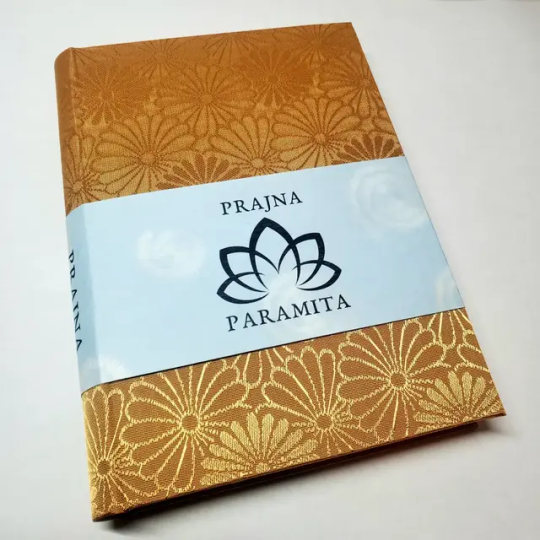
If you're already printing your own textblocks, an easy step for titles is to print them. Above is a title printed onto an "obi" of decorative paper. I measured out where I wanted things on the finished book and laid it out in Affinity, then printed it on a full sheet & trimmed it down to wrap around the book. A more simple method is to print & glue on the label into a slight indent in the cover (to protect it). A third option is to do the spine in bookcloth, while you print on paper for the cover and then glue that paper onto the boards (this usually looks even better when it is a three-piece bradel bind).
2. Foil Quill / Heat Pens
The heat pen is one of my go-to tools, but it can be a bit touchy about materials. The most popular version is the We R Memory Keepers' Foil Quill (which is one of the most ergonomic), but other pens exist that can get you to a higher heat temp, finer lines, or more consistent foil. For example, I have a pen created by a local Japanese bookbinding studio that fares way better on leathers than the WRMK quill & with a finer tip, but it's hell to control. Best results in general are on paper or smooth bookcloth (starched linen, arrestox, colibri - even duo will work but its less solid). The fuzzier a bookcloth is, the less your foil quill wants to deal with it. This means the heat n bond method of making bookcloth does not play nice with a heat pen usually, but there are two solutions: 1) use this tutorial on paste + acrylic medium coated bookcloth instead that will get you a perfect surface for the heat pen, or 2) use the pen on paper & then glue onto the cloth. I did a video tutorial for both foil quill use and this type of homemade bookcloth for @renegadeguild Binderary in 2023.
You get the most consistent results by tracing through a printed template that is taped in place, as I do in the video above.
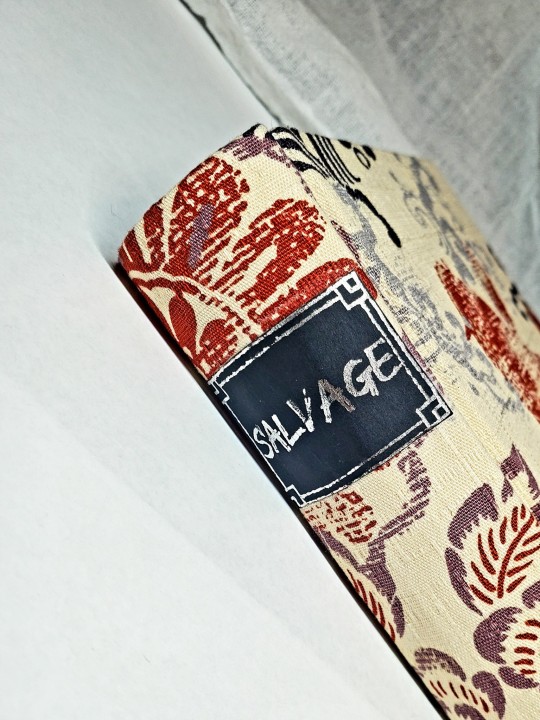
3. Paint That Shit
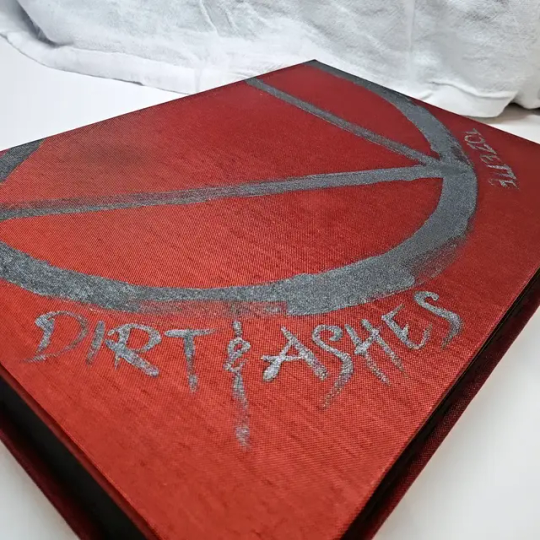
Acrylic paints will do you fine! The above is free-handed with a circle template, because I wanted that vibe. If you need straight lines that won't seep, lay them down with tape first & then paint over it first with a clear Acrylic medium, then your color. Same goes for stencils. Two more examples of painted bookcloth:
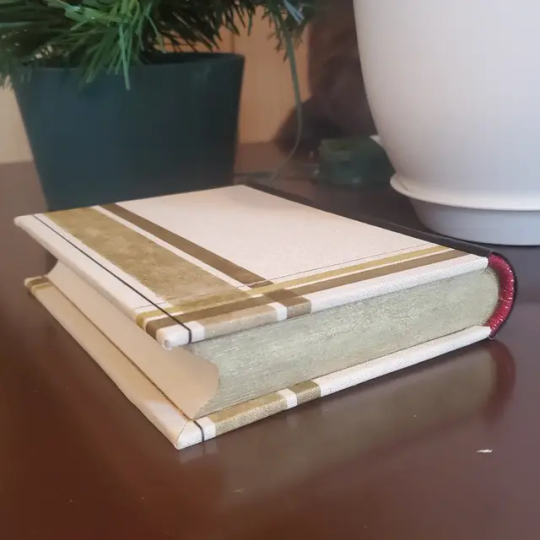
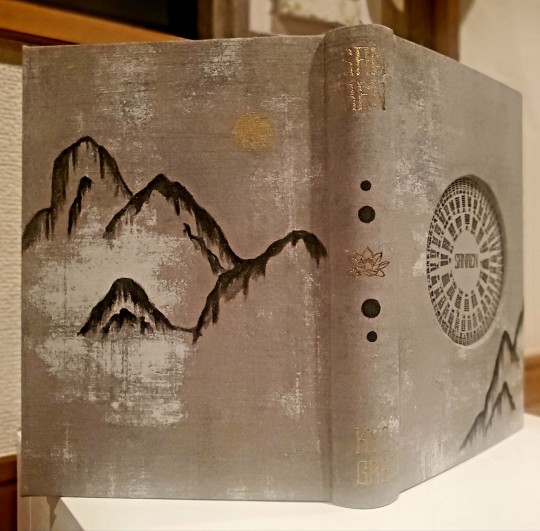
4. IT'S GOT LAYERS
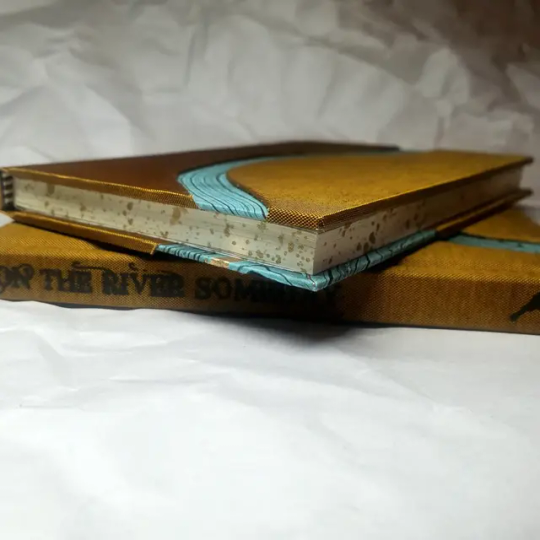
By using layers of thinner boards, you can create interesting depths & contrasts on your cover. You can also make cutouts that peep through to the decorative paper behind. The most important part to this technique is the order in which each edge is wrapped. To get a good wrapped inside edge, you will split the turn in into tabs to get them to conform to a curve. You can also layer multiple colors of bookcloth without multiple layers of board, as seen below left, so long as you mind your cut edges for fraying.
5. Inlaid... anything
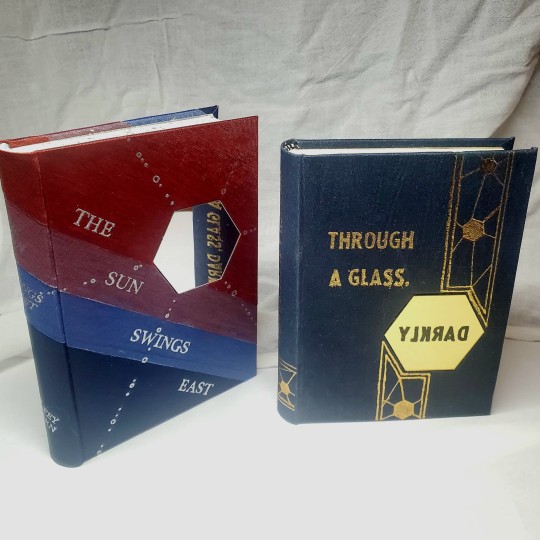
Mirrors! Marbled paper! I saw someone do a pretty metal bookmark once! The key is creating a little home for it to live in, which is pretty similar to the above layering method. On one layer you cut the shape, & glue that layer onto the bottom solid board before covering. You can do the top layer as an entire 1 mm board (like I did for the mirrors) or a sheet of cardstock, like I would use for inlaid paper.
6. Decorative Paper
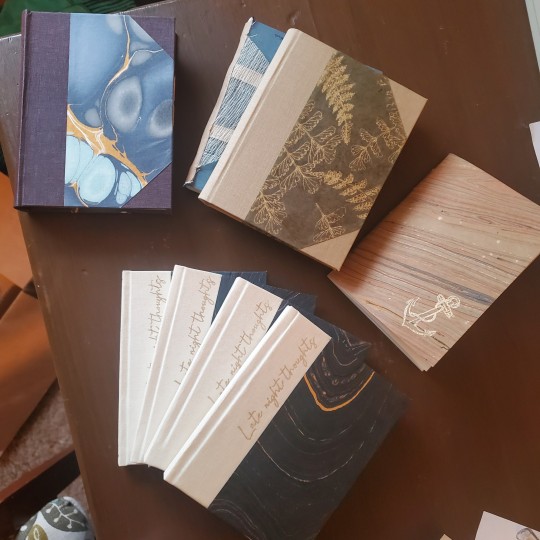
Decorative paper is always helpful & adds to the paper hoard... & its effects can be layers with other techniques, as below. Marbles, chiyogami, momi, or prints & maps of all kinds can be great additions. Some papers may need a protective coating (such as wax or a sealer).
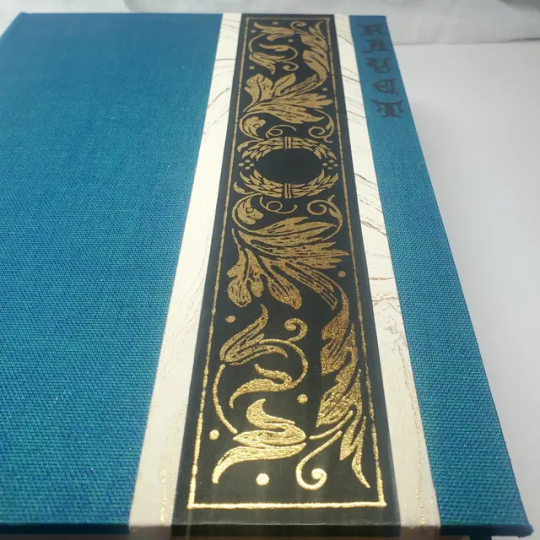
7. Stamps (with optional linocut)
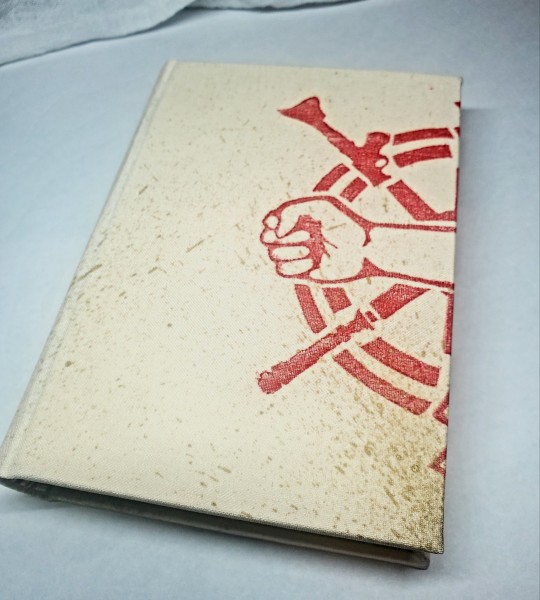
While I've not used many more regular rubber stamps, I do know some who have, successfully! And I've used one once or twice with embossing powder (see photo 3 up, the gold anchor on the little pamphlet bind). What also works is to carve your own linocut or stamp, & then use block printing ink to ink it onto your fabric (as i did above). A bit time intensive, but it was nice how easily reproducible it was, and I liked the effect I got for this particular bind.
These methods are not exhaustive, just ones I've used, and there are of course many others. I haven't gone too into detail on any of these for the sake of length (& post photo limits) but feel free to ask about more specifics. Usually I'm using them in combination with other options.
#fanbinding#bookbinding#celestial sphere press#ficbinding#in progress review#bookbinding how to#i am not particularly anti-cricut or anything#it's just a very expensive tool#and its prevalence sometimes makes new binders think they HAVE to get one#when they absolutely do not#you can make pretty books without it
1K notes
·
View notes
Text
Subtle ways to serve the patriarchy in your daily life:
1. Be respectful
When talking to strange men, always refer to them as "sir" or as a "gentleman." This may seem outdated, but some people still talk like that. It shows your respect and harkens back to a time when men were in charge and women knew their place.
2. Be polite
Always say please and thank you, even if it doesn't seem necessary. For example, instead of saying, "Hey, do you know where the restroom is?" say, "Excuse me, sir, could you please show me where the restroom is?"
3. Be dependent
If you go out with a man, let him hold your phone. He'll decide what you need to see and who you need to communicate with. If he goes through your texts and photos, that's his right.
4. Be a doll
If you go out with a man, let him choose your outfit, how you do your makeup, and your hair. Don't leave until he is completely satisfied with your appearance.
5. Dress to impress
If you go out without a man, choose makeup and an outfit based entirely on what you think men find attractive. (Unfortunately, you will have to use your brain just a little bit for this one 😥) It doesn't matter if you like it, or if it's comfortable, men's taste is your taste.
6. Be helpless
If you think you might need help with something, ask a man. Even if you think you could probably do it on your own, remember that you can't. If you're lost, don't try to use Google maps. Ask a man for help. If there's something wrong with your car, don't even try to figure out what it is, take it to a mechanic, and say, "It makes a weird noise when I do this" and let him handle everything for you (ideally you wouldn't be driving at all)
7. Be approachable
If ANY man flirts with you or compliments you, be receptive. If a dirty homeless man says you have nice tit's, smile at him and say, "Thank you, sir." If a group of men are hollering at you, stick around, give them a spin so they can see and judge every part of your body, invite them to come over and grope you.
8. Be submisive
Never talk back to a man. If a man is rude to you, be grateful for the attention and ask him what you can do to make it right.
9. Be dumb
Don't use big words, in text or in speech. If you have an idea that you don't know how to express, it's probably too complicated for you. Only read when you have to. Never try to understand current events, occupy your mind with porn. If you really need more intellectual stimulation, you can watch something like celebrity gossip news.
10. Spead the word
Subtly try to teach other women their place, compliment them on their appearance, and nothing else. Discourage them from valuing things like their education and career. Encorage them to dress more slutty, if possible get them drunk and makeout with them for men to watch.
#bimboification#dumb puppy#bimbo training#patriarchy kink#bdsmkink#bdsmblog#bimbo doll#dumb slvt#cnc free use#degrading k1nk#degredation kink#dumb wh0re#r@pe fantasy#c0cksleeve#human fleshlight#fr33use
3K notes
·
View notes
Text
Bayverse!Donnie headcanons bc his my bbg
Okay, lol, I really needed to let all of this out and just vomit all the ideas I’ve been hoarding about this man. I love him. I’ve adored him ever since the 2012 series, and that made me realize—I definitely have a thing for nerds. And glasses. Dear god.
I hope you guys like this!! Do you think I should do the same for the other brothers? Or maybe for the other characters? (I wouldn’t mind taking the risk and making headcanons like this for Rocksteady, hehe.)
Alright, bye!!
warnings: sfw & nsfw ( but not so explicit?) :p
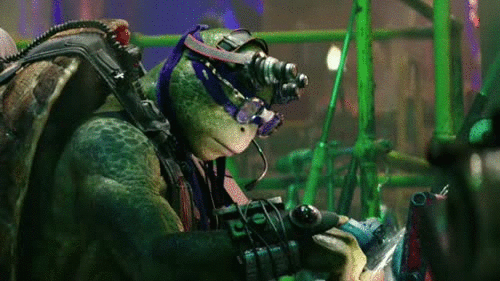
- He’s a genius with confidence… until he isn’t.
Donnie is incredibly self-assured when it comes to his intellect and skills. He knows his worth and never doubts his ability to solve problems. Jumping out of a plane without a parachute? Easy. Hacking government security systems? A piece of cake. But confessing his feelings to you? That’s a whole different challenge.
This is where his anxious side kicks in. His brain, used to solving any equation, completely short-circuits when it comes to emotions. What if he misinterprets your signals? What if he ruins the friendship? What if you like someone else? Sure, he can design an exoskeleton in less than 24 hours, but love is a field where variables don’t always make sense.
If you think you can hide something from him, think again. Donnie notices everything. From the slight shift in your expression when you’re tired to the pattern of songs you repeat when you’re feeling down. (And no, he absolutely did not hack your Spotify, ahem—)
- That’s why, when you start falling for him, he already knows. In fact, he probably figured it out before you did.
He won’t tell you right away. Inside his head, there’s a storm of chaotic thoughts, organizing themselves into an ultra-detailed data table with every relevant piece of information. Give him a few days, and once his mind has fully processed everything, he’ll come back to you as a renewed Donnie—determined, confident, and ready to make you his.
- Donnie doesn’t just plan things; he breaks them down into a thousand strategies of action. His trash bin is living proof of the number of ideas he discards and reworks over and over.
Gifts? He’s not the type to grab something generic at the last minute. His gifts are so deeply personalized that they’ll make you feel like he knows you better than you know yourself.
Example: If you ever casually mentioned that you’d love to learn to play an instrument, he’ll build one for you—customized with enhancements. If you said you love the stars, he’ll create an interactive star map with the exact alignment of the sky on the day you were born.
Your birthdays, anniversaries, and any special dates are planned years in advance. It doesn’t matter if you’re not officially together yet—he already has ideas saved for when you are.
- Romance in his brain is an equation far too complex.
Donnie isn’t clumsy because he lacks intelligence; it’s because his brain moves too fast. His emotions and logic are in constant conflict, creating an ongoing battle between Confident Donnie and Nervous Donnie.
You’ll see him go from saying something with complete confidence to, “Uh, well… what I meant to say is… no, wait, forget it—” and then getting frustrated with himself because that definitely wasn’t what he had in mind.
But when he manages to organize his thoughts, he’s one of the most direct people you’ll ever meet. Once he crosses the mental line of “I’m doing this,” there’s no turning back.
- Gifts
He doesn’t believe in generic presents. Everything he gives you has a specific purpose. A bracelet that’s actually a disguised tracker (“For safety. Just for safety.”), or a stuffed animal that can record voice messages.
One day, you wake up and find a new app on your phone with your name on it. You open it, and it’s a virtual assistant designed specifically for you, complete with personalized reminders for the little things Donnie knows you always forget.
- Once he has you, you are his priority.
Once Donnie accepts his feelings and takes the step to be with you, he becomes the most devoted boyfriend.
He’s not excessively clingy or jealous like Raph, but his love is obvious in the time and effort he invests in you.
No matter how many projects he’s juggling, if you truly need his attention, he’ll give it to you without hesitation.
- Donnie needs physical contact, but his intellectual pride won’t let him admit it outright. Instead, he prefers to justify it with overly precise scientific explanations.
“Well, you see… my body temperature tends to drop faster than that of the average human, so it’s biologically beneficial for me to share contact with an external heat source.”
Translation: “Hug me. Now.”
If you confront him with something like, “Why don’t you just say you want cuddles?” he’ll turn bright red and start stammering, scrambling for excuses.
Don’t listen. Just climb onto him.
- Donnie can plan everything, but he cannot predict your spontaneous displays of affection.
If you surprise him with a kiss, his brain completely shuts down for 3-5 seconds before he can process it.
Unexpected gestures—hugging him from behind while he’s working, cupping his face in your hands, or kissing his cheek out of nowhere—leave him frozen, recalculating.
Sometimes, his first reflex is to adjust his glasses, only to realize that they have nothing to do with the fact that his vision just blurred from sheer shock.
NSFW
- He’s patient… but only to a point. Donnie will never pressure you. He’ll wait as long as you need, always making sure you feel safe and comfortable.
However… he’s already undressed you with his eyes a million times.
His mind is a machine of ideas and theories, and when it comes to you, he has imagined everything. Everything.
He tells himself he can be rational and controlled… but if you take too long, his thoughts will become a little more persistent.
- He’s not innocent. Don’t even think it for a second.
He may seem shy or awkward about relationships, but when it comes to this, his mind is a laboratory of hypotheses he’s dying to test.
He has analyzed you with surgical precision. He knows exactly how you blush, how you react to certain touches, which words make you tremble.
Do not underestimate him. He has read, he has researched, he has learned.
But nothing compares to the real thing. With you.
When he finally has you in his hands, his brain short-circuits.
No matter how many times he imagined this moment, nothing could have prepared him for the feeling of your skin beneath his fingers.
His jaw clenches, he exhales sharply, and his pupils dilate as if he’s just been electrocuted.
His entire expression changes—from his usual nervousness to something darker, more intense, starving.
- He becomes obsessive about memorizing every single reaction of yours.
He’s analytical. He will learn what you love and make sure to do it better every single time.
Eye contact and sounds. His drug.
Look at him. Don’t look away. Don’t ignore him.
If you dare to hold his gaze while he’s above you, he will completely lose himself in you.
Your voice, your moans, your gasps—they ruin him.
He needs you vocal. He needs to know he’s doing a good job.
If you get shy and try to cover your mouth, he will ask (or demand) that you don’t.
Kinky? Oh, absolutely.
Donnie lives to experiment. It’s in his nature.
Positions? All of them. But his favorites are the ones where you are on top of him.
He loves being dominated.
After spending his entire life controlling every aspect of his world, it’s a relief for his mind to surrender completely to you.
“Set the pace, beautiful. I’m in your hands.”
Toys? Oh, yes.
You can be sure he has researched every single thing about them.
But he won’t settle for the ones that already exist. No.
He will build his own. Upgraded. With precisely calibrated speeds and optimized materials.
“This one has five vibration levels, but if we increase the frequency by 15%, we could—”
May God help you if you walk into his lab at the wrong time.
May God help his brothers if they ever find out.
Dedicated and obsessed with you.
Donnie doesn’t do anything halfway. If he gives himself to you, it’s completely.
No matter how much time passes, he will always give his all to make you feel incredible.
He’s not a casual lover.
He is yours. And you are his.
“You are my greatest discovery.”
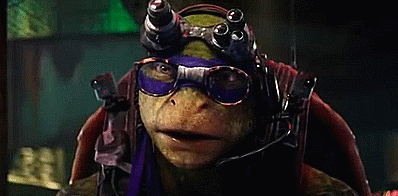
#tmntbayverse#bayverse tmnt#bayverse donnie#donnie x reader#bayverse donnie x reader#fluff#tmnt headcanons#reader#tmnt x reader
554 notes
·
View notes
Text
My Favorite Cheap Art Trick: Gradient Maps and Blending Modes
i get questions on occasion regarding my coloring process, so i thought i would do a bit of a write up on my "secret technique." i don't think it really is that much of a secret, but i hope it can be helpful to someone. to that end:

this is one of my favorite tags ive ever gotten on my art. i think of it often. the pieces in question are all monochrome - sort of.
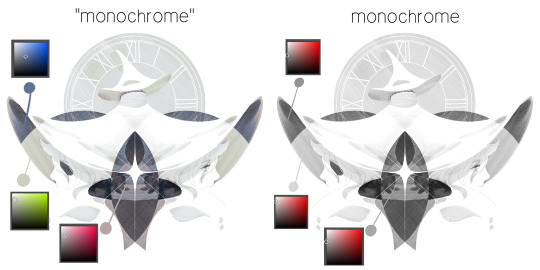
the left version is the final version, the right version is technically the original. in the final version, to me, the blues are pretty stark, while the greens and magentas are less so. there is some color theory thing going on here that i dont have a good cerebral understanding of and i wont pretend otherwise. i think i watched a youtube video on it once but it went in one ear and out the other. i just pick whatever colors look nicest based on whatever vibe im going for.

this one is more subtle, i think. can you tell the difference? there's nothing wrong with 100% greyscale art, but i like the depth that adding just a hint of color can bring.
i'll note that the examples i'll be using in this post all began as purely greyscale, but this is a process i use for just about every piece of art i make, including the full color ones. i'll use the recent mithrun art i made to demonstrate. additionally, i use clip studio paint, but the general concept should be transferable to other art programs.

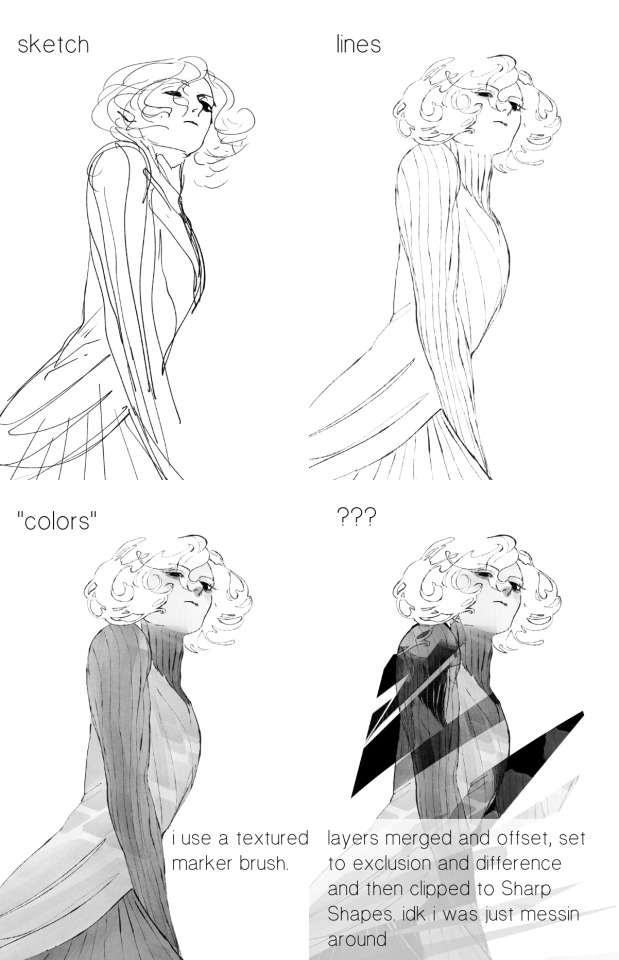
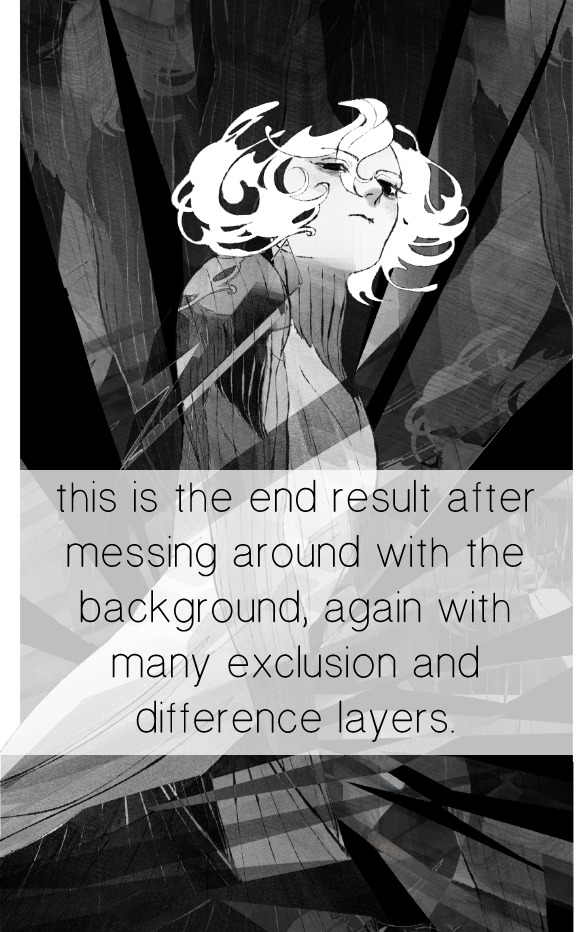
for fun let's just start with Making The Picture. i've been thinking of making this writeup for a while and had it in mind while drawing this piece. beyond that, i didn't really have much of a plan for this outside of "mithrun looks down and hair goes woosh." i also really like all of the vertical lines in the canary uniform so i wanted to include those too but like. gone a little hog wild. that is the extent of my "concept." i do not remember why i had the thought of integrating a shattered mirror type of theme. i think i wanted to distract a bit from the awkward pose and cover it up some LOL but anyway. this lack of planning or thought will come into play later.
note 1: the textured marker brush i specifically use is the "bordered light marker" from daub. it is one of my favorite brushes in the history of forever and the daub mega brush pack is one of the best purchases ive ever made. highly recommend!!!
note 2: "what do you mean by exclusion and difference?" they are layer blending modes and not important to the overall lesson of this post but for transparency i wanted to say how i got these "effects." anyway!
with the background figured out, this is the point at which i generally merge all of my layers, duplicate said merged layer, and Then i begin experimenting with gradient maps. what are gradient maps?
the basic gist is that gradient maps replace the colors of an image based on their value.

so, with this particular gradient map, black will be replaced with that orangey red tone, white will be replaced with the seafoamy green tone, etc. this particular gradient map i'm using as an example is very bright and saturated, but the colors can be literally anything.
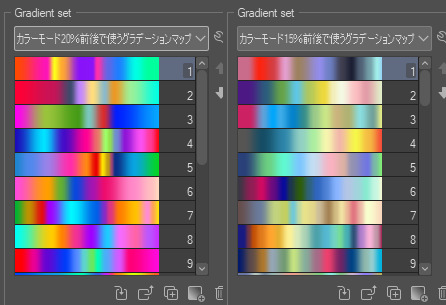
these two sets are the ones i use most. they can be downloaded for free here and here if you have csp. there are many gradient map sets out there. and you can make your own!
you can apply a gradient map directly onto a specific layer in csp by going to edit>tonal correction>gradient map. to apply one indirectly, you can use a correction layer through layer>new correction layer>gradient map. honestly, correction layers are probably the better way to go, because you can adjust your gradient map whenever you want after creating the layer, whereas if you directly apply a gradient map to a layer thats like. it. it's done. if you want to make changes to the applied gradient map, you have to undo it and then reapply it. i don't use correction layers because i am old and stuck in my ways, but it's good to know what your options are.

this is what a correction layer looks like. it sits on top and applies the gradient map to the layers underneath it, so you can also change the layers beneath however and whenever you want. you can adjust the gradient map by double clicking the layer. there are also correction layers for tone curves, brightness/contrast, etc. many such useful things in this program.
let's see how mithrun looks when we apply that first gradient map we looked at.

gadzooks. apologies for eyestrain. we have turned mithrun into a neon hellscape, which might work for some pieces, but not this one. we can fix that by changing the layer blending mode, aka this laundry list of words:

some of them are self explanatory, like darken and lighten, while some of them i genuinely don't understand how they are meant to work and couldn't explain them to you, even if i do use them. i'm sure someone out there has written out an explanation for each and every one of them, but i've learned primarily by clicking on them to see what they do.
for the topic of this post, the blending mode of interest is soft light. so let's take hotline miamithrun and change the layer blending mode to soft light.

here it is at 100% opacity. this is the point at which i'd like to explain why i like using textured brushes so much - it makes it very easy to get subtle color variation when i use this Secret Technique. look at the striation in the upper right background! so tasty. however, to me, these colors are still a bit "much." so let's lower the opacity.
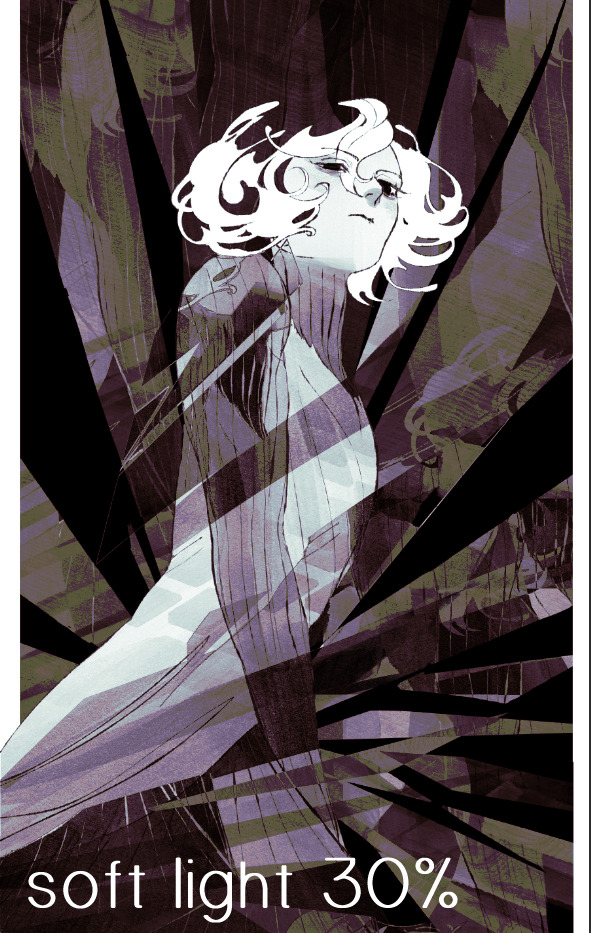
i think thats a lot nicer to look at, personally, but i dont really like these colors together. how about we try some other ones?
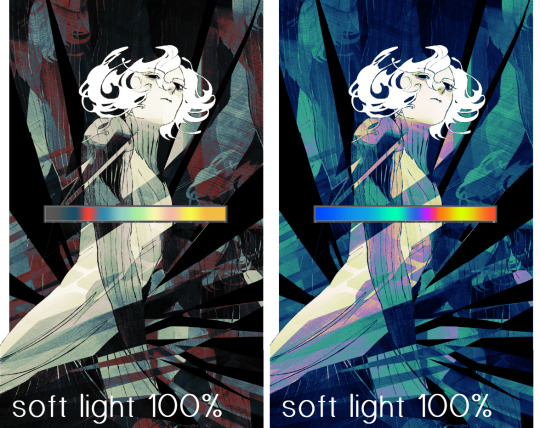
i like both of these a lot more. the palettes give the piece different vibes, at which point i have to ask myself: What Are The Vibes, Actually? well, to be honest i didn't really have a great answer because again, i didn't plan this out very much at all. however. i knew in my heart that there was too much color contrast going on and it was detracting from the two other contrasts in here: the light and dark values and the sharp and soft shapes. i wanted mithrun's head to be the main focal point. for a different illustration, colors like this might work great, but this is not that hypothetical illustration, so let's bring the opacity down again.
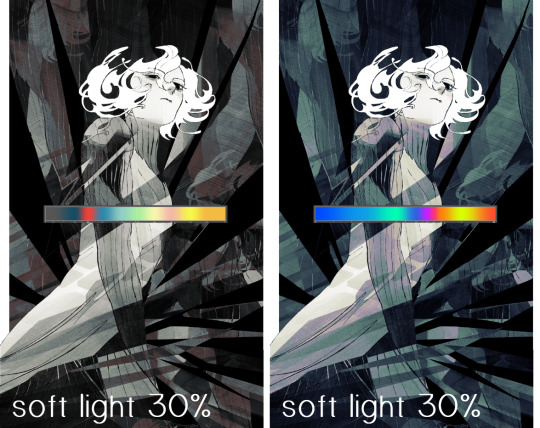
yippee!! that's getting closer to what my heart wants. for fun, let's see what this looks like if we change the blending mode to color.
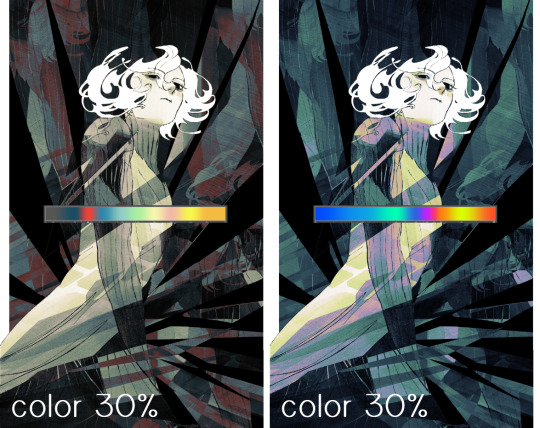
i do like how these look but in the end they do not align with my heart. oh well. fun to experiment with though! good to keep in mind for a different piece, maybe! i often change blending modes just to see what happens, and sometimes it works, sometimes it doesn't. i very much cannot stress enough that much of my artistic process is clicking buttons i only sort of understand. for fun.
i ended up choosing the gradient map on the right because i liked that it was close to the actual canary uniform colors (sorta). it's at an even lower opacity though because there was Still too much color for my dear heart.
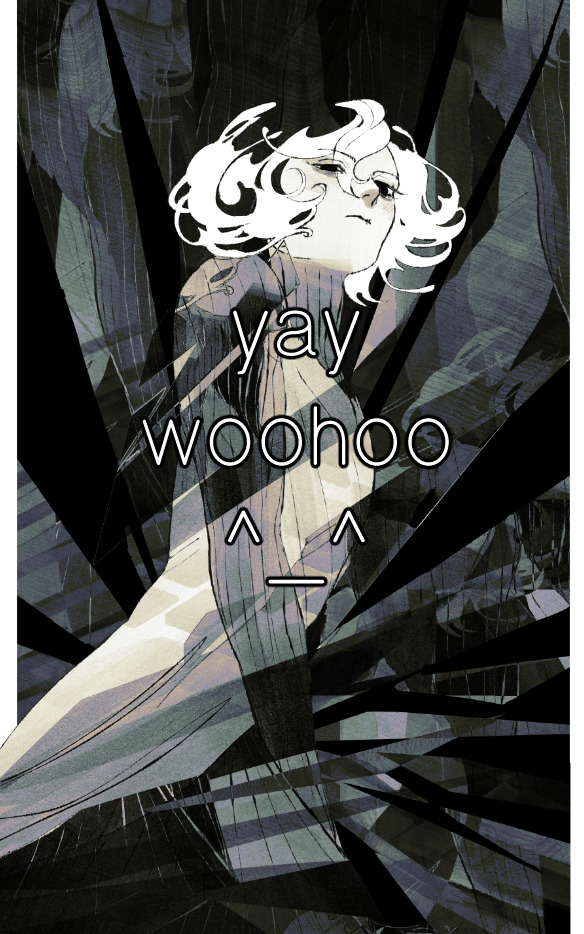
the actual process for this looks like me setting my merged layer to soft light at around 20% opacity and then clicking every single gradient map in my collection and seeing which one Works. sometimes i will do this multiple times and have multiple soft light and/or color layers combined.
typically at this point i merge everything again and do minor contrast adjustments using tone curves, which is another tool i find very fun to play around with. then for this piece in particular i did some finishing touches and decided that the white border was distracting so i cropped it. and then it's done!!! yay!!!!!
this process is a very simple and "fast" way to add more depth and visual interest to a piece without being overbearing. well, it's fast if you aren't indecisive like me, or if you are better at planning.

let's do another comparison. personally i feel that the hint of color on the left version makes mithrun look just a bit more unwell (this is a positive thing) and it makes the contrast on his arm a lot more pleasing to look at. someone who understands color theory better than i do might have more to say on the specifics, but that's honestly all i got.
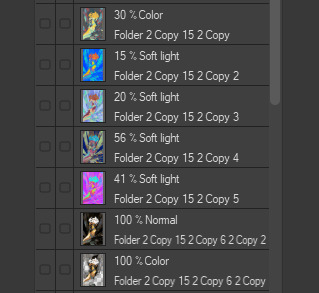
just dont look at my layers too hard. ok?
2K notes
·
View notes
Text
Writing Notes: Detailed Settings

A detailed setting draws your readers into the world you’ve built, allowing them to inhabit the storyline. Learn the core elements of setting, and apply them to your own writing.
How to Create a Vivid Setting for Your Story
Writing vividly is all about evoking clear imagery and detail in the mind of the reader. Here’s how to create a richly textured world for your story:
Use place to your advantage. Place denotes both geographical location and immediate surroundings. A story that unfolds in the hurried chaos of New York is not the same if transplanted to an isolated island in the Pacific. A scene that takes place in a cramped room shifts when it occurs in a vast forest.
Make use of time. Time in setting can be expressed as a time of day, a season or time of year, or a historical time period. Seasonal changes—the advent of winter, a blistering summer—might provide life or death stakes; historical periods define the behavior of all the characters operating within your fictional world.
Show the world through your characters’ eyes. Try to reveal the world as the characters interact with it, since the most resonant setting descriptions are the ones that come somewhat altered through the lens of an individual. If you’re writing historical fiction, for example, you may be pulling from a real place or time. Snippets of accuracy can give palpable energy to your prose. As with anything that requires lots of research, knowing what to include can be a balancing act: too much detail, and the reader is overwhelmed.
Be aware of how setting affects emotions. Allow setting to influence your characters’ actions and moods. Otherwise, they and the world they live in will come across as static and lacking nuance. The lives of humans—or mythical creatures living in fantasy worlds—are intimately tied to setting.
Exercises for Writing Vivid Settings
Try these writing exercises to develop a strong story setting and see where it takes your narrative:
Visit a real-world location you’ve never been to before. This can be an actual place from a setting you’ve chosen or simply a place near you that you find interesting. When you first arrive at the location, don’t record or photograph or write anything down, just spend some time absorbing it through your senses. Pay attention to the things that strike you most. Go home later and write a description of the place. Remember to include the sensory details—what it felt and smelled and sounded like.
Select an important location from your novel or short story. This could be anything—a public building, a business, a famous landmark, a landscape, or someone’s house. Now choose two characters from your story and write a short paragraph describing how they might react to the setting. Explore different points of view of your chosen place.
Choose places and write them on index cards. Organize them according to how you think a story should unfold at those locations. Would it make more sense for your characters to move from one theme to another (e.g. from religious buildings to scientific ones)? What’s the most efficient way to organize them? Would a random route be more interesting?
Focus on memorable details. Keep the details grounded in a character’s sensory experience. Everyone probably knows what a tree looks like, so if you’re describing one, tell the reader what makes it different or why it’s important from your character’s point of view. You’ll want to let your reader know what it feels like for the character, what it sounds and smells and tastes like. No matter what kind of world you’re creating, this technique can bring more vividness to your writing.
On an unlined sheet of paper, create a map of your world. Pay attention to detail: Even the smallest moments can help you visualize a world more clearly. Show landscape features like mountains and lakes and roads; mark cities if you have them, and note regions and counties, too. Try to match the feel of your setting. If it’s a magical world, show features pertaining to this—a dark magician’s fortress, for example.
Source ⚜ More: Notes & References ⚜ Writing Resources PDFs
#setting#description#writing tips#writeblr#literature#writers on tumblr#writing reference#dark academia#spilled ink#writing prompt#creative writing#writing advice#on writing#writing inspiration#writing ideas#light academia#lit#writing resources
333 notes
·
View notes
Text
How the "divine feminine" and the "divine masculine" perpetuate patriarchy - and what we can do about it
One thing the occult is very good at is coming up with systems to categorize and conceptualize things. These can be incredibly useful to us in various ways. But we also have to remember that these systems we come up with are mere constructs, and the actual world itself probably doesn't conform to them as we might like. As the saying goes, all maps are wrong. But as the saying also goes, some maps are useful, and some are more useful than others.
One thing that often comes up in esoteric and occult systems are various forms of binaries or polarities. This often makes sense; for example, without light, you have dark. Without heat, you have cold. One party gives, the other takes. Creatures are born, and eventually they die.
But we can run into problems when we start trying to lump all apparent forms of polarities and dualities together. Here's an example: Life/Death, Masculine/Feminine. In doing this, we create an association that might lead us toward some terrible ways of thinking about real people. If we associate masculinity with death, we can find ourselves thinking that waging war and inventing weapons of death is just what men and masc people do, but women can always be counted on to be diplomats and peacekeepers. Or if we associate femininity with death, we might find ourselves more inclined to think that women and femmes have a natural desire to commit infanticide and tear apart societies, and they must be carefully watched and their freedoms limited so they don't upend civilization and endanger the human race.
These are of course extreme examples, but they are real ways that some people think. And you might think to yourself, "well, I don't polarize genders this way, I think people should try to be a healthy balance of masculine and feminine." And if this is you, I want you to ask yourself why you're so attached to categorizing traits as "masculine" and "feminine" at all.
If you're like most people, you probably just came across this in some form of occult or spiritual literature and just adopted it without really asking yourself too many questions about it. When we see something framed as ancient or higher wisdom, it's pretty easy to take it fairly uncritically, especially if it aligns with our unconscious biases in some way. It often doesn't cross our minds to ask where these terms really come from, and what they signified in their original contexts.
You may have heard that male/female stuff has roots in alchemy, which is true. But the thing with alchemy is that it was using familiar terms and concepts to describe chemical processes and reactions. Think of it a little bit like how we use terms like "male plugs" and "female plugs." While old-time alchemy did have a spiritual component to it, it was more about believing that you had to be spiritually pure to make your desired alchemical reactions happen. When alchemy gave way to chemistry, and people began to realize that your spiritual condition had nothing to do with your ability to make things happen in the lab, certain people began to seek more mystical meanings in the works of alchemists, and this idea of masculinity and femininity as transcendent mystical forces unto themselves really started to emerge. It was an incredibly easy concept to project on all kinds of mythologies, because a lot of myths have male and female figures interacting in various ways.
Now the thing is, having myths with male and female figures doesn't mean seeing masculinity and femininity as discrete forces or powers unto themselves. It can mean that they simply personified various figures as male or female depending on what their own experiences and cultural biases suggested to them. For example, straight men tend to think of love and lust as something they experience when they see a beautiful woman. In a patriarchal society, where men are calling most of the shots in conceptualizing the divine, a love deity is thus likely to be personified as a beautiful woman. Straight men can also see beautiful women as a source of discord and strife, so it makes sense that love goddesses would have war aspects to them.
A society where men are sent to war while wives are left behind to raise the children and tend the farm is going to produce an association with men and violence, while the act of nurturing will be associated with women. Men who deny higher education to women are going to produce a society where intellectual pursuits and higher abstract reasoning are associated with masculinity, and intuition and practical knowledge are associated with women. A society where men are seen as bringers of social order and upholders of civilization while women are viewed more like forces of nature than rational actors will associate men with civilization and women with natural, wild spaces.
In continuing to associate these characteristics with the "divine feminine" and the "divine masculine," we preserve and perpetuate the implicit biases created by these patriarchal societies. And while there is absolutely value in saying, "hey, these 'feminine' things are actually valuable and worth respect actually," framing them as intrinsically feminine in any sense - physically, psychologically, or metaphysically - will undermine any effort to dismantle patriarchy and bring true equality.
So what can you do? I would suggest being more specific.
Do you mean passive/active? Then just say it.
Do you mean giver/receiver? Then just say it.
Do you mean harmonizing/disrupting? Then just say it.
Whatever you have filed under boxes labeled "masculine" and "feminine," you can simply take them out of those boxes and find better categories for them.
413 notes
·
View notes
Text
From Professor Christopher Robichaud, Senior Lecturer in Ethics and Public Policy, Harvard:
“I'll say this, and then I likely won't be saying much more on here for quite some time, to the relief of some, I'm sure. But my farewell warning is this.
Everyone in the days and weeks ahead will use this loss as an opportunity to seek validation for their own hobby horse complaint. Harris lost because she campaigned with Liz Cheney. Harris lost because she didn't embrace Gaza. Harris lost because she didn't choose Shapiro. Harris lost because she wasn't progressive enough (possibly my favorite one).
Take a good, hard look at the map, my friends. Trump has won the popular vote. Trump ran the table. Explaining that with your hobby horse issue isn't going to cut it, tempting and consoling as it may be. The problem isn't the electoral college. The problem isn't that we didn't have a full primary. The problem isn't Harris. The problem isn't that Dems didn't have the right message. The problem isn't even inflation or the border.
The problem is so much worse than any of those things. Those are all technical problems, with straightforward expertise fixes. If only it were so! No, our problem is not technical. It's very much adaptive. A party that embraced the Big Lie, supported an insurrection, and has been selling conspiracy-addled madness for years, [which] was widely and enthusiastically embraced. Voter turnout was profound! People didn't sit this out.
Simply put, the problem--as some of you have rightly posted--is cultural. America, culturally, has completely abandoned a politics of decency and respect and has embraced instead a politics of resentment, revenge, false nostalgia, and bullying. And if you look at the demographics, you also won't be able to comfort yourself that it's just a white thing, or a working class thing, or an education thing. It's multi-class, multi-gender, multi-educational, and multi-racial. That's what winning the popular vote means. That's what running the table amounts to.
A culture that has descended to this level of debasement is not easily fixed. In fact it may not ever be fixed. The timeline for changing something like this is decades--at best--not two-to-four year election cycles. You can extend that in this case, because with the GOP likely controlling all branches of federal government and the courts, they will ensure that mechanisms are in place to keep them in power long after their popularity has waned. You can count on that.
The GOP evolved into a party of rage, lies, and revenge--and it correctly diagnosed that there was and is a large appetite for that. That's what the country wants. At least enough of the country wants it to ensure broad appeal and widespread electoral success. The old GOP will never return, and the Dems have nothing to say to American culture at the moment. Nothing. They've been speaking to a country that's gone, like dust in the wind.
And that's my final thought, which my posts last night alluded to. The America I knew and loved is gone. This new America--nah, I won't even bother. I will say that cultural change is less likely to occur in politics or in the academy. You're not going to get people to see how vulgar they've become through a clever argument or a nice campaign speech, that's for sure.
This would be time for the arts, broadly understood, to step in. The arts can change hearts and minds. Too bad the arts have been systematically dismantled in education in this country, and on the other end, the tech industry's assault on the arts through AI is sure to hollow out any good-faith efforts that might emerge.
And for the rest of the world, America's rightward lurch is, I'm afraid, bad news for you too. I know you know this. Because it's not isolated, is it? It's just at the moment the most prominent example of a burgeoning trend. And this will embolden others in other countries, to be sure. We need not speculate what happens when countries become mired in lies, embrace resentment, and savor bullying. We know exactly what happens. Bloody conflict and global destabilization.
The first quarter of the 21st century will, therefore, in hindsight, be viewed as the seed-planting stage for the absolute shit show that's about to unfold globally over the next two and a half decades. Count on it.
Adopt whatever coping and endurance strategies you have available. You're going to need it.
I think that's all I've left to say.”
The least evolved. The most paternalistic.
The bully. The liar. The most resentful.
This is the reality we are in. FOX and Republicans have been repeating the script for decades.
The Dark Ages are conservative aspirations.
The abdication of values/principles is complete.
'Good faith' no longer exists on the Right. The more reprehensible the action/person, the bigger the addiction. Trump proves this.
Anti-paternalism, anti-fascism and anti-bullying are my paths forward. Join me.
473 notes
·
View notes
Note
Hi there! I love your work so much <3
Do you think we could get some headcanons of how Hiccup would react if the reader kept flirting with him?
No rush! Take your time and take care of yourself!
A/n: hi there <3! Thank you so much 🥹🫶🏼. When I saw this request I was like, "oh heck yes."
Warnings(?): flirting (lol), a lil short as well.
'Not Shy Of A Spark.'

Right away, Hiccup would know when you're purposefully trying to flirt with him. He isn't stupid. He's seen you do it before.
If you're not one to flirt constantly, then it'll definitely fluster him more when it comes out of nowhere. If you're the opposite, however, he's more used to it but still tries to hide the fact that his ears get slightly red whenever you decide to do something flirtatious.
He honestly doesn't know how to handle it most of the time; he'll just stand there and take it while avoiding your eyes - if possible.
I mean, he's never been flirted with in the past, so his reactions are always the funniest to you.
"You're a fresh target!" You'd say.
There would be one instance where he was trying to show you some new islands he found on his map, not looking up at you yet because he was so engrossed in explaining every little detail about it. You eventually got bombarded with how much rambling he was doing, not that you didn't like it, and you silently began to stare at him as he continued talking.
With an idea striking your mind, your hands slowly went up to his hair, brushing a small stranded piece away from his face, causing him to pause in the middle of his sentence. Hiccup turned towards you, a questioning gaze settled on your hand. "Uh, something wrong..?"
You shrugged, a faint smile on your lips, "No.. I just find you more interesting to look at than a map.. to be honest."
Hiccup blinked, taking in your words for a moment before he realized what you were saying. He slightly shifted in his seat, feeling a warmth crawl onto his face as he tried to hold eye contact. "U-uhm, sorry, was I boring you out--?"
"No, no, not at all. It gives me more time to look at you, so I'm happy. I also like hearing you talk, no worries." Your hand brushed against his as he silently got the signal and held it together with his, glancing down at them for a moment.
"Haha, very funny." He muttered sarcastically, lifting his eyes up to yours once more as he tried to hold his ground.
Hiccup didn't want to appear like he got flustered so easily, even though he did, because he just felt that way whenever you did those things overtime - like he wanted to prove himself or something.
Or, perhaps get you back for it.
"No, I'm serious!" You gently rubbed your thumb on his hand, slightly tilting your head as you gazed at him with a challenging glint in your eyes. "What? Can I not look at you?"
He shook his head, sighing as he tried to fight against the warmth on his face, "I'm.. not saying.. that." Hiccup, with a sudden idea crossing his mind, sat up straighter, copying your actions as he moderately tilted his head, "Only if I can do the same thing."
Eventually, it just kind of becomes a silent game between you two of who can make the other more flustered. Hiccup loses most of the time.
I said most.
For example, when he said that to you, it did manage to startle you a bit.
Overall, Hiccup does get flustered rather quickly, but he's also swift to recover and do the same to you if he's feeling bold enough for it in that moment.
------------------------------------
#hiccup haddock#how to train your dragon#httyd#hiccup how to train your dragon#hiccup httyd#httyd hiccup#hiccup horrendous haddock iii#hiccup x reader#how to train you dragon: the hidden world#httyd fanfiction#httyd 2#🐢 hehe
552 notes
·
View notes
Note
hello!!! if you don't mind me asking, what is your process when transitioning from sketch/value map to working in colour? it's something in the painting process that i find difficult to bridge. i have trouble finding people talking about this online beyond that one trick everyone talks about that makes the colours look muddy. but your work has some incredible colour & you've spoken about value mapping being important when you start a piece. any insight would be super appreciated :0 (i really love your work by the way!!!!)
Hello! When transitioning to the coloring phase, I find that having an anchor point or anchor color within the piece helps me immensely with avoiding disjointed visuals.
An anchor point is a starting subject in your piece that helps with establishing what color/mood your piece will be. It assists with achieving color harmony and unity.
My anchor points generally differ from drawing to drawing, but for interior landscapes, I usually use the wallpaper as my anchor.
Once I've picked my anchor, I try and settle on a tone I want to stick to when coloring. In my example below, I chose a warm tone that primarily utilizes yellow. Since orange is an analogous color to yellow, it can be used to subtly accent the piece without overpowering the pallette.

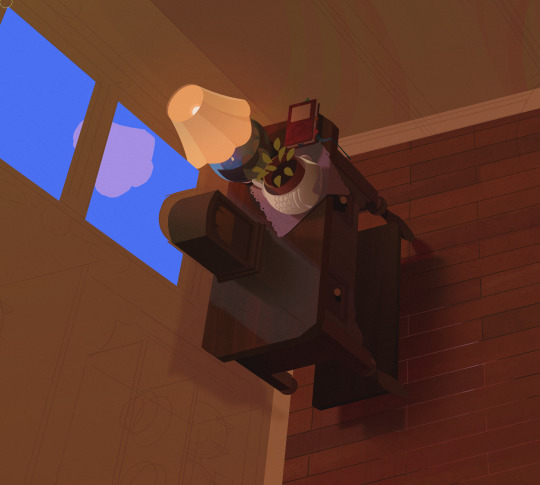
Now that I've picked the colors for the main bulk of my drawing, I can use complimentary colors in order to create a smooth color contrast without making it feel too incoherent. Below, you can see that I chose blue since it's complimentary to yellow.


My value map hereafter is only really used as a loose guideline for me to make sure nothing looks too light or too dark compared to its surrounding environment.
Its also helpful for me to map out how things will look once they're filled in. It's really easy to not notice mistakes when you just have the lineart/sketch, but by filling in the spaces where furniture or characters will be, it helps bridge the gaps on how it'll look with an actual form. It really helps with weeding out small mistakes from the start so that they don't snowball into bigger issues once you're farther down the line.

I apologize if this isn't a very intelligible explanation, I'm working on getting better at delineating my process currently, but I know how confusing some of my wording can be sometimes when describing how I draw.
209 notes
·
View notes
Text
So, the Dead Boy Detectives version of Hell is pretty explicitly based in Dante’s Inferno. In Dante’s Hell, the outer circle is Limbo, then next is Lust, then next is Gluttony… sound familiar? The methods of torture used aren’t the same as in Dante’s version (for instance, Lust’s torture is supposed to be a violent storm, symbolizing the howling darkness of helpless discomfort that is sex, or… some such nonsense) but the sins that get you categorized in Hell do seem to be the same (as is the Circles’ arrangement).
So please imagine for me, then, Edwin, fresh out of Hell, desperate to not go back, coming up with schemes to bolster his argument for Heaven-bound status, even forming his entire profession and afterlife’s work partly around that. And think of how Edwin is familiar with the layout of Hell, has mapped it, has been through it all and knows all the sins and their punishments.
I rather suspect that that Edwin would have a mental list of Sins in the back of his mind, and run his every action and word past it before doing or saying anything.
But the thing is, you see, Dante’s Inferno is… comprehensive. And overlapping and somewhat contradictory. You can barely act at all without running afoul of one of the Sins or other, desperately trying to thread a needle of temperance.
The Circle of Greed, for example, punishes both the avaricious and miserly, and the “prodigal” who squander their wealth. The Circle of Wrath punishes not only the actively wrathful but also the sullen, the passively wrathful, so suppressing your anger doesn’t cut it, either. (And that’s separate from the Violence area - the people in Wrath aren’t even violent, they’re being punished for just feeling anger.)
So Edwin would be all but paralyzed, at first, shying away from one Sin only to bounce back towards another.
I think within a few years the realities of living (after-living) combined with Charles’s modern sensibilities and some hefty self-reflection, and a certain amount of belief that Hell isn’t going to snatch him up at any moment, would lead Edwin to easing up. But still, I think, there would be a few things that just stick. Sins with particularly horrible punishments, or areas he spent a lot of time in or adjacent to, or just.. things that, for whatever reason, form a block in his mind.
(We know he seems to have trouble with Lust - they try to drag him down as though he is guilty.)
Perhaps, every time he tells Charles what a great detective he is, there’s a part of Edwin’s mind reminding him that Flatterers are submerged forever in a river of human excrement.
Perhaps, though he uses plenty of magic that might be called “dark”, his absolute line is divination; he won’t use any magic to see the future, thanks to the Eighth Circle’s Fourth Bolgia, which punishes those who pervert God’s laws to view the parts of God’s plan which have not yet been revealed. (It includes astrologers; Monty is forbidden fruit, a scandalous dip into sin, in more ways than one.)
Perhaps he is hesitant to sow discord between kinsmen, to cause family disunion, because the punishment is to be dismembered, hacked to pieces, pulled apart like you have pulled apart a family. (Perhaps if Charles had been abused by someone other than his father, Edwin might have responded more readily.)
197 notes
·
View notes
Note
Hands you a mic. Talk about the religions in ISAT please.
fumbles with the mic as the suddenly spotlight floods from above with a click
ohhh there's so much to talk about with this!!
as i said here, there's actually a bit of an overlap of between the change belief and the universe belief. it can only be expected, of course; the two countries are extremely close in proximity and beliefs of different cultures that have some trace similarities, often even started off from the same base source, a bit like languages!
to sum up the similarities from that post, both the change god and the universe have to do with fate and your place in the world. they're about leading you through life, offering protection and support during your journey through life and its avenues.
that's not to say these religions don't clash; first off all, the change god clearly has some divine beef with the universe and we'll get to it, but besides that there are certainly some foundational differences that you can see really well when the party examines the first key we can find - the circle key, the symbol of the change belief, portraying how everyone and everything belongs to this world.
siffrin can, after some time, question that even if the smaller circles are within bigger ones, the biggest one is not inside of anything. in their first reaction, and thus most honest one, they're quite indignant and ruffled about it, and even later throughout act 2 they seem wholly unconvinced.


this is of course because siffrin's faith has an explanation for it that the change belief lacks, although we don't learn about it until act 4, when they seem to not be able to hold it in anymore.

that's the first crucial discrepancy - the thing inset into the belief in the universe is the sense of belonging to something bigger than you can imagine, bigger than your mind can envelop. the change belief seems, in contrast to that, more cozy, approachable. this fits well with the concept of the houses of change that serve kind of as community centers for help and self-betterment, and with the housemaidens that serve as examples, help others fulfill their goals or help them get better, be it skill- or health-wise.
(the rest of this long ask response is under the cut for care of mobile users that can't use the J hotkey)
the change belief is about providing you with safety during your inner journey so that you can become your better self. it doesn't need anything bigger than the world because the world is where all the people are. the universe belief needs the world where everything and everyone is to be within something else because it's about trusting something bigger than you is in charge of your fate and keeping you on track.
i said this already in the other post, but the change belief largely focuses on your end goal. you can take any road you want, in any length of time you require, and take any measures you want in order to achieve change. in the end, what matters is that you've achieved it. the universe is completely the opposite here - it values your journey and your experiences during it, it leads you so you can safely follow it, and you'll end up where you're supposed to be because of that.

the universe, unlike the change god, in not an advisor; it requires your blind trust and perhaps baseless faith, and honestly this might be why the change god mocks the universe as a god that doesn't even talk to you.

they explain pretty well why the time loop goes against their nature; after all, the end goal slips from the story's grasp every time. they don't care for all the fluff between the points on the map, they want the result most of all. this ceaseless wandering is not their domain; it's the universe's. the change belief needs the possibility of change and evolution and the universe requires you to follow and journey both inward yourself and outward to the world to know and understand both—
HA! I HAVE TRICKED YOU AND LULLED YOU INTO A FALSE SENSE OF SECURITY!!! THIS POST IS ACTUALLY A HIT PIECE ON THE KING
if you really think about it, the king goes against the principles of both the religion of the country he grew to call his new home, and the country he hails from. him freezing vaugarde stops everyone from changing, making them stay exactly the same forever, but that part is clear from the text and rebuked by the party, especially by mirabelle. however, his wish also stops everyone and himself from advancing forward, from continuing the journey. he clings onto the scraps of the past with fear and desperation and is too scared to just trust the universe to lead him into a life that's different but no less good. he'd doubly a hypocrite.
if you can't take my word for it, siffrin's might do. after the event of the king trying to coax them into saying the name of the northern island with him, regardless of what you pick, this is how siffrin, who seems to be a pretty devout believer in the universe, seems to sum it up.

siffrin in general seems to have accepted that his home is gone - not in that he doesn't care or that he made peace with it but in that he is fully aware nothing can bring back what's been lost. it's gone forever and that's that.
(honestly that sense of finality seeps into even things that are far from being concluded often and siffrin overdoes it by accepting his conjectures as final truths that can't be changed. but that's neither here nor there)
the king twists the fact his wish got granted into approval rather than a tool for his journey, a goal that the universe sets you out in. because that's what wishes are - the universe sets and reroutes a path towards them for you, braids your fate in such a way that it's bound to come true. no wish in isat, when granted, gives you something material; you can't just ask for a new bike and have it materialize in front of you. the granted wishes, siffrin's and the king's, most prominently, aren't granted for their own sake. instead, they assist them in leading them to the fate that was preordained for them; the king, at the cost of being frozen himself, gets to remember all he lost and keep it with him forever in that form, and siffrin's wish, as broken as it is, makes him realize him and his family can and will stay together. you get exactly what you need to self-actualize as best as possible while enroute to the resolution of your wish. but the journey is the resolution, the process is the reward itself. that's what the universe's deal is.
(as for the expressions, we get very little on them but they seem the most typical to the pantheon of gods we're familiar with. they remind me a lot of the muses; an essence you seek guidance in that you hope will imbue you with its domain.)
thank you sooo much for giving me space to ramble about this ake you're the best ╰(*°▽°*)╯
#this response took so long sorry fdjghj i had a lot to yap about#in stars and time#isat#isat meta#isat spoilers#isat siffrin#isat king#in stars and time spoilers#pondering#cosmic soundwaves#siffrin#the king#isat change god#isat the universe#long post
190 notes
·
View notes
Note
Hi! My friend is a big fan of your art, and they asked me to ask you for tips on how you draw hair. I'm no artist, so I probably shouldn't be the one to ask these questions, but would you mind sharing a few suggestions? Any pointers about your character designs or your art style would be greatly appreciated. Thanks so much, and hope you're having a good day! <3
Hiya!! I tried to breakdown my approach to drawing hair here, but these are by no means hard and fast rules! Hope this helps :)
1: The Hairline
I usually start with the hairline. I like to break it down into 4 main sections, that I can play around with:
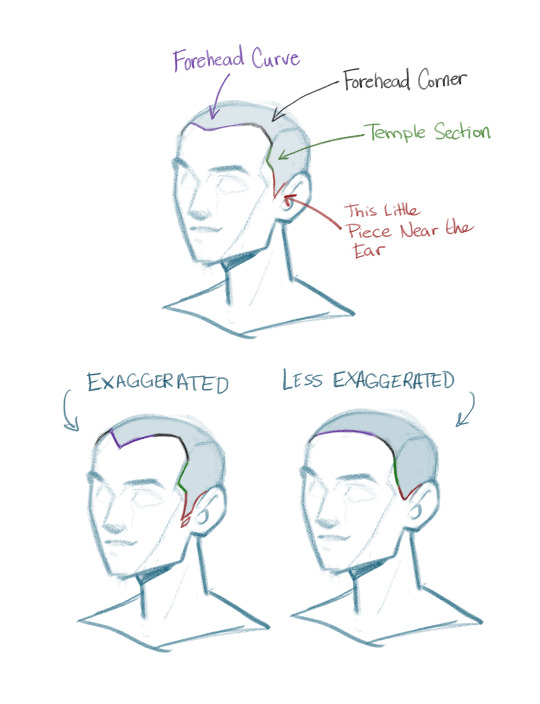
I like to try to line up the temple section with the ridge of the side plane of the head
Try to have the hairline follow the natural flow and planes of the head
There's a gap between the hairline and the ear (often it gets covered up by longer strands of hair, but if you're drawing a short cut or pulled back hair, you'll probably see it)

2: The Silhouette
I like to draw out the silhouette next. Sometimes I'll use the lasso and fill tool, so I don't get wrapped up in extraneous details.

Try focusing on finding an appealing shape for the hair, and how it will frame the face
Consider how thick you want the hair to be and it's texture
(I find this is also a good time to flip the canvas to make sure the weight feels balanced)
Try to avoid having tangents with facial features, if you're drawing bangs or face framing pieces
Keep in mind how outside factors may affect the hair (like if there's a breeze, or if the character is lying down, or if they've tucked a piece behind their ear, ect.)
Try to keep shape variation in mind. A small shape next to a big shape is often more appealing than 2 medium shapes side by side
I also like to play with a lot of straight/curved line variations to make the shapes look interesting
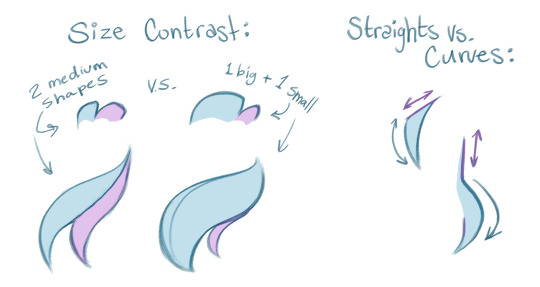
3: Flow & Volumes
(I usually just visualize this step, rather than drawing it out like this)
Basically try breaking down your silhouette into big volumes, and know where the hair pieces coming from and where they're going.

^For example, the hair on top, is brushed froward, with no defined part, so the chunks that we can see start at a cowlick at the back of the head and spiral out from there. The hair on the bottom however starts at the part, shwoops up, and then cascade down in 2 layers.
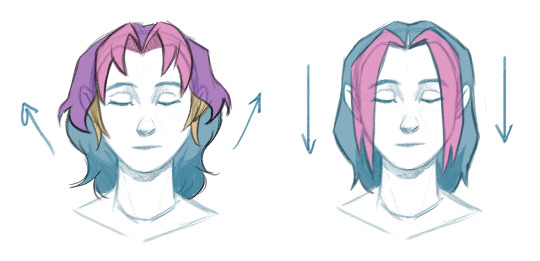
^Another note: more layers usually means more volume wherever the layers are placed, longer hair pieces will weigh the hair down, meaning less volume.
4: Details
Once I have an idea of what the hair is doing, I draw out the chunks of hair, following the volumes and flow I've mapped out. Sometimes I'll do a little bit of hatching to indicate volume or texture.
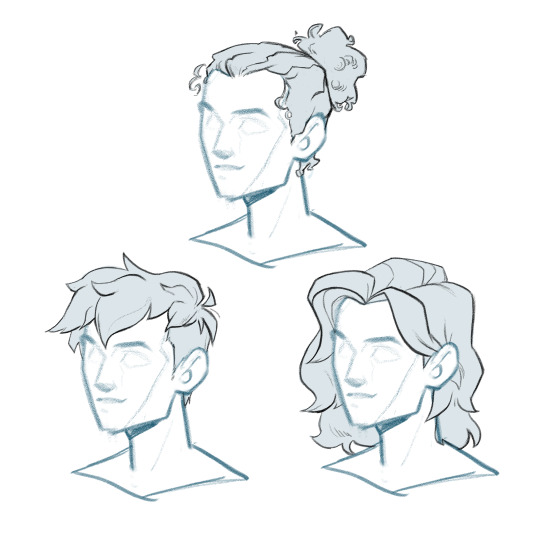
I often like to choose 1 or 2 shapes for my clumps, based on the hair texture, and then repeat those shapes throughout:
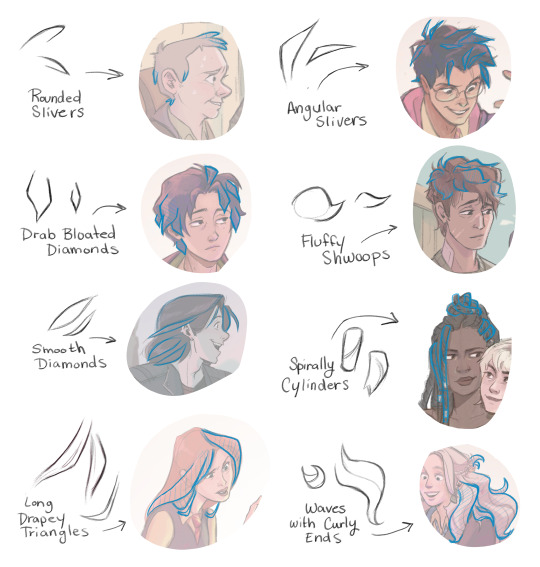
Vairy the size of your clumps
Beware of overworking it at this stage, sometimes less is more yk? And too much detail near the face can be distracting
Make lines on the silhouette and lines closer to the front thicker (especially if it's overlapping another line)
You don't have to draw every strand. Sometimes I'll break up big clumps with a thinner inner line, but I try not to go overboard with this. You can also indicate strands by adding little cutouts to the silhouette, like this:
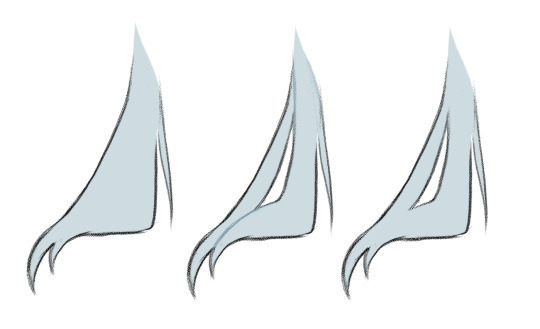
5: Rendering
My process for rendering hair is pretty much the same as it is for anything else. Base colour layer>shadow layer>highlight layer.

I like to use the lasso/fill tool here again for shadows, and then soften them up a bit by going over some of the harsh lines with a pencil brush
For shadows, I usually just do a multiply layer with a lowered opacity, clipped to the base colour layer and then use a bright red or purple colour
Highlights and shadows can also be used to indicate more hair clumps that you haven't drawn in
Try to think of the shadows as big graphic shapes, that fall where the light won't hit, and wrap around the forms of the hair
I personally don't like to go crazy on the highlights, but when I do, it's usually for dark hair, since shadows don't show up as well on darker hair
Shiny glossy hair, usually has brighter highlights with harsher edges
Also black hair isn't usually pure black unless it's a stylization thing or the lighting is reeeally dark
Sometimes once I fill in the hair, I'll look at it and go "ew why's it look dumb now?" Sometimes the warp or liquify tool can help with refining the proportions to rectify this and sometimes you just have to cut your loses and redraw stuff :P
Then as a final touch a may add a few stray strands of hair that break off from the main shape
Ok that's all! Hope your friend has fun drawing hair! Have a great day <33
248 notes
·
View notes